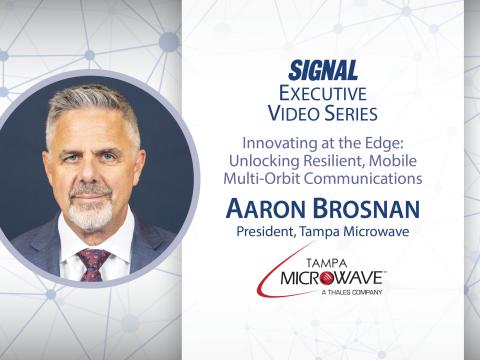Signal During the Final Decade of Analog Communications
 This is the fifth in a series of interviews with signaleers, one for each of SIGNAL Magazine's seven decades, to commemorate the 70th anniversary of AFCEA International.
This is the fifth in a series of interviews with signaleers, one for each of SIGNAL Magazine's seven decades, to commemorate the 70th anniversary of AFCEA International.
1966-1975
As a Marine serving in the Korean and Vietnam wars, John Hopkins used line-of-sight and various portable radios, or PRCs, to communicate in the field. The “AN” in the AN/PRC-6 meant that it was a piece of military electronics and not a truck or a weapon, and operated using wideband frequency modulation (FM). The range of this handheld radio was about 1 mile, but much less in the jungle.
The 82-year-old veteran remembers other versions; the PRC-8 was for tanks, the PRC-9 for artillery and the PRC-10 for infantry. Artillery could talk to infantry on a small, narrow band, and artillery could talk to tanks, but infantry could not talk to tanks. “That was just the way the FM radio world was constructed then,” Hopkins says.
The retired major has been a full witness to the digital revolution—the change from mechanical and analog electronics to digital technology that continues to alter the way information is created, shared and consumed at unprecedented speed.
The Army was making much bigger strides in radio technology than the Marines from the mid-1960s to the mid-1970s, Hopkins recalls. In 1966, the Army was using the PRC-25, which was the first solid-state radio, designed for use in a vehicle or on an aircraft. Before its introduction, radios were almost all tubes—think walkie-talkies.
Hopkins remembers putting one, sometimes two, of these solid-state radios in a jeep during missions. The antennas he needed to attach were 25 or 30 feet long, so they had to be tied down to the front bumper. “When we drove through jungles or villages, there was obviously the risk of these fiber antennas snapping,” Hopkins relates.
Soon, both the Marines and the Army started using tactical radio communication (TRC). While the Marines only had radio capabilities for four channels, the Army had at least triple this capacity with the AN/TRC-12 or the AN/TRC-24. “The antennas looked like giant fly swatters, but they were 12- and 24-channel radios, which were really super multichannel radios at the time,” Hopkins says.
Toward the end of the Vietnam War, the Army once again was ahead of the Marines in radio technology and began using satellite radios. More importantly, the Army provided single-channel voice service for the U.S. embassy in Saigon using the AN/TSC-54, a mobile satellite terminal. It was stored in a van with an antenna roughly 26 feet in diameter and relied on generators to operate.
According to Hopkins, during the fall of Saigon, Graham Martin, the last U.S. ambassador to South Vietnam, used the satellite to tell Gerald Ford, “Mr. President, I am closing the embassy and evacuating.”
During Operation Frequent Wind, the final phase of evacuation of American civilians and at-risk Vietnamese from Saigon, Marines were forced to destroy the satellite terminal.
“The events of 1975, for all practical purposes, I think ended the analog world of communications,” Hopkins says. The U.S. State and Defense departments and the president wanted concrete evidence of orders being given to close the embassy, and that would not have been possible without satellite communications, he posits.
The year before, in 1974, Hopkins and some friends started the Quantico-Potomac Chapter of AFCEA. He still has his membership card from that year. The chapter created an important outlet for him to discuss the communication changes they were all starting to witness.
“There was a group of us who were born in the 1930s, and we kept hearing the words ‘the digital world’ without fully understanding what it meant,” Hopkins says. They had studied analog communications, and some had grown up without even a radio in their house.
Hopkins returned to the field during Operation Desert Storm, this time as a civilian contractor. “I always say [Desert Storm] was the testbed for the research and development going back to 1975. One of the most striking things that happened is now we have satellites, which we first started testing in the 1970s, sending imagery down to Earth into the command posts,” Hopkins says. “That was big.”
Today’s glut of new technology is at times a bit overwhelming to the octogenarian. “Every time I see something new, it almost shocks me. All of my children and grandchildren have these beautiful iPhones that they can talk to, and the phone talks back,” Hopkins says.
He also has observed a significant change with data storage. “When you look at the digital devices today, there are megabytes, gigabytes, terabytes. I have no idea how many zeros are out there.
“You hear a lot about [the National Security Agency] and megadata. Megadata is just a new word for traffic analysis. If you’re looking at telephone numbers and create a network, that is basically what we did, except we looked at frequency usages by our enemy to create battle orders,” Hopkins says.
“It was a heck of a world to grow up in. I’ve seen the full evolution of the analog world into the digital world,” he concludes.




Comment
In 1968 I was an instructor
In 1968 I was an instructor in the 31M20 course at Fort Gordon and worked the field week for setting up the antennas for the AN/TRC 24 and the actual broadcasting to the other radios. At that time the field course was just above where Riot City was, for riot training
Comments